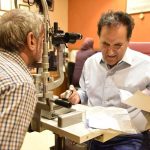Ocular Health and Risk Factors
- Alcohol
Excessive drinking of alcohol can cause short-term and long-term effects on vision and eye health. Alcohol may slow pupil reaction which results in difficulty in distinguishing between objects in lightness and darkness. It results in impaired peripheral vision and tunnel vision. This makes it harder for your pupils to react, so they can’t constrict or dilate properly. Even common tasks, such as driving at night, can become a challenge with the direct impact of headlights decreasing reaction times. Alcohol may also cause blurry and distorted vision due to the slow pace of communication between neurotransmitters in the brain. Overconsumption of alcohol can also result in an increased occurrence of dry eye and eyelid twitching. All these are short-term consequences and may likely be recovered once you stop drinking.
The long-term consequences of Prolonged alcohol abuse on vision may include toxic amblyopia (due to a toxic reaction in the optic nerve), increased risk of age-related macular degeneration, increased risk of developing a cataract, affecting various areas of the central nervous system, including visual functions and affecting eye movements.
- Smoking
Studies show that smoking can develop serious eye conditions and threats your eyesight. In comparison with people who do not smoke, smokers are twice as likely to develop age-related macular degeneration and two or three times more likely to develop cataracts. Smoking may also increase the risk of glaucoma, diabetic retinopathy, and dry eye syndrome.
- UV Lights Damage
It is surprising to know that the eyes are as vulnerable and susceptible to sun damage as skin. UV lights damage almost all ocular structures including the eyelid. Corneal damage, cataracts, and macular degeneration are all possible chronic effects of UV exposure and can ultimately lead to decreased vision. Other sun damages include photokeratitis which is a sunburn on the eyes, Pterygium, and Solar Maculopathy.
- Computers
people spend an average of 6 to 9 hours a day staring at Computers and digital screens. As of 2018, it is estimated that 84% of the world’s population is using some sort of digital screen device. This number is only expected to rise in the coming years. Prolonged use of digital screens, including but not limited to computers, tablets, and cell phones may result in a vision problem called Computer Vision Syndrome (CVS). The symptoms associated with this syndrome are included but not limited to eye strain, blurry vision, dry eyes, headaches, neck and shoulder pain, farsightedness, astigmatism, inadequate eye focusing or coordination, and changes in vision due to aging.






